
That’s a long title, but it’s been a long road for Green Arrow since his debut in More Fun Comics #73 in 1941. This big book highlights that history with a series of short stories focusing on different periods of his career.
The book gets off to a brilliant start with a tale paying tribute to the Golden and Silver Age version, the Battling Bowman who fought crime in Star City alongside his ward Speedy, his quiver full of gimmicks.

How cute is Roy, steaming angrily like a red dragon? The full-colour art by Javier Rodriguez is delightfully imaginative, while keeping our heroes on model. Rodriguez is playing off a sterling script from Mariko Tamiki, while letterer Andworld Design comes into their own in a panel laying out the content of that famous quiver. I wish DC would do a regular anthology dipping in and out of its history so tales like this were more than an occasional treat.
There’s another total winner as writer Tom Taylor and artist Nicola Scott, partnered with colourist Annette Kwok, take us back to the time Ollie trained at the gym of Ted Grant, the JSA hero Wildcat.

With fine character moments, sharp nuggets of humour and a surprise villain, it’s a one-two punch of greatness.
The artist on the much-lauded Green Lanter/Green Arrow series isn’t in this comic, but Chris Mooneyham brings a nice Neal Adams vibe in a story set during the Justice League of America’s satellite-era. Even if it weren’t a fun romp, perfectly capturing Bronze Age Ollie, writer Stephanie Phillips deserves a million points for her title, ‘Who Watches the Watchtower?’

Writer-artist Mike Grell gave Green Arrow a whole new audience in the Eighties with his Longbow Hunters mini-series and the regular run that followed. He dumped the trick arrows as Ollie starred in a gritty urban drama, with nary a super-villain in his new city of Seattle. Oh, and Ollie was OK with killing criminals. This approach wasn’t my cup of tea, so I never followed the series, but I can appreciate Grell’s craft. And his brilliant talent is on display here as Green Arrow teams up with the assassin Shado to end a people smuggling operation.

Ram V has an intriguing idea for his story, using Longfellow’s The Arrow and the Song (‘I shot an arrow into the air…’) to frame a series of vignettes set throughout Ollie’s life. Unfortunately, it feels like I’m missing the significance of the scenes – why are Ollie and Dinah in the snow, what’s this beach party? – while the loose-looking art by Christopher Mitten is a shock to the system after everything that precedes it. And a couple of times letterer Aditya Bidikar makes the fancy italics font used for the verse yellow which, against a blue sky background, is tough to read.
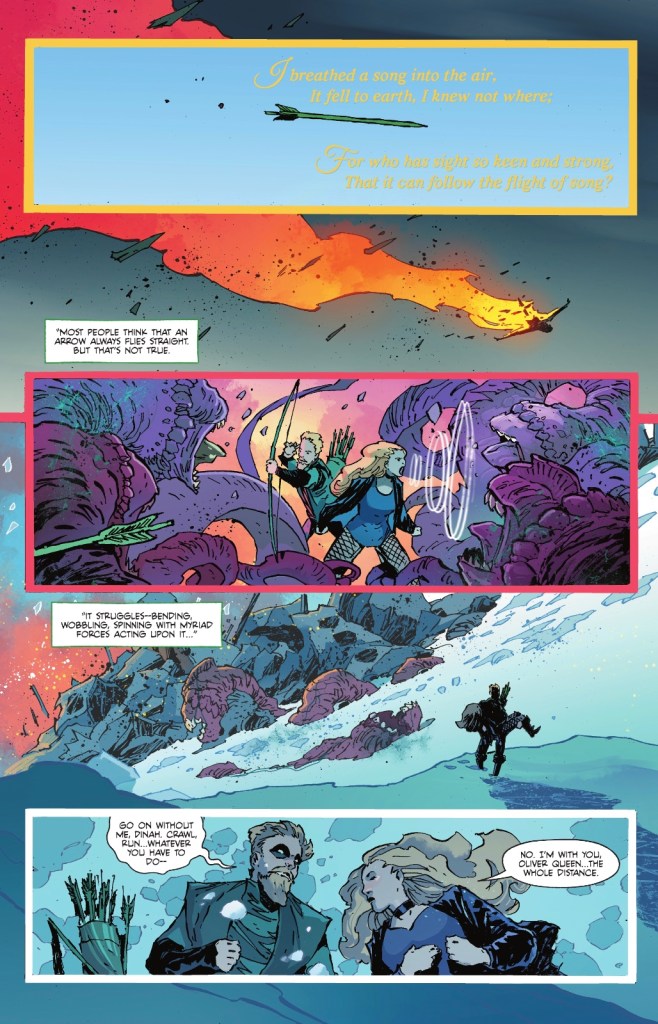
Conner Hawke proves he can fight bad guys as well as his dear departed dad in a good-looking extended fight scene from writer Brandon Thomas, and artist Jorge Corona. A supporting character keeps wittering on about JLA villain the Key, so looking up the ‘new’ Green Arrow’s links to him added much-needed interest.
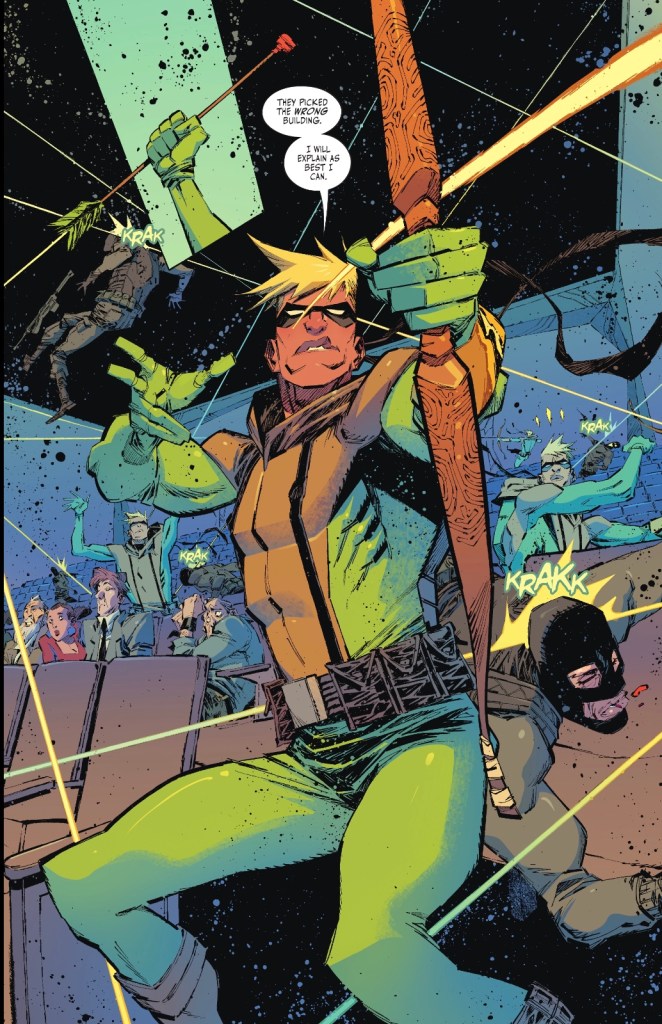
Roy Harper takes centre stage in a tale about a tale, as the former Speedy, here Red Arrow, phones in a bedtime story to daughter Lian and babysitter Ollie. Devin Grayson has found a clever way to recap and reframe Roy’s troubled history, and Max Fiumara’s full-colour art is terrific, but a clunky lecture cum public service announcement at the end pours cold water on a heartwarming moment.
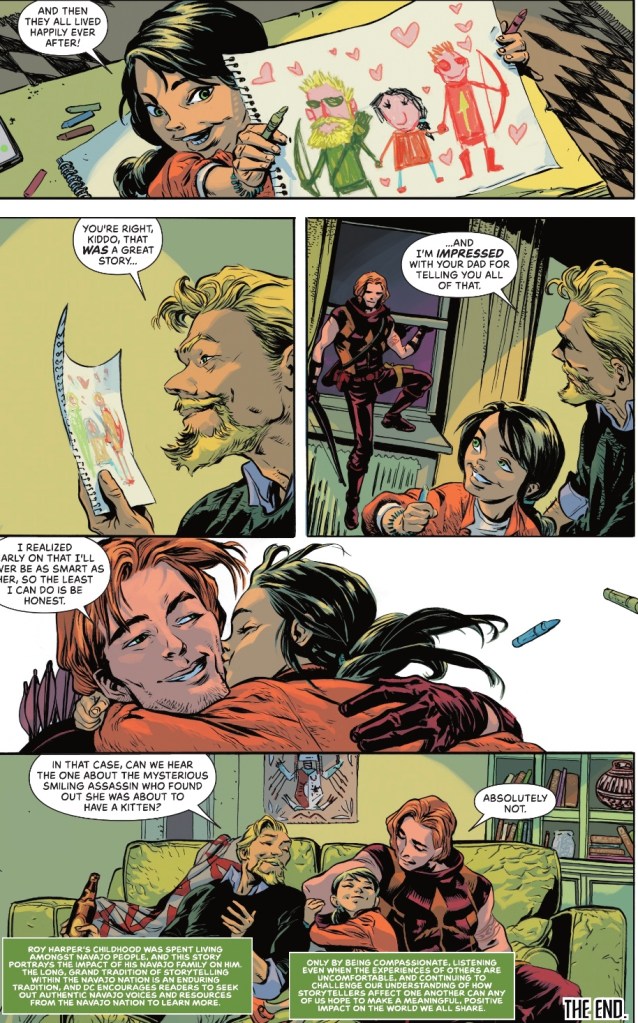
Former Green Arrow penciller Phil Hester writes and draws a lovely story demonstrating Ollie’s intelligence and compassion as he bids to rescue a very special child. Hester’s old partner Ande Parks is back on inks, ensuring this is one of the best-looking entries in the issue.

Vita Ayala writes and Laura Braga draws a smart, good-looking focus on the relationship between Ollie and Dinah, pointing out that despite what soap operas tell us, secrets can make life better.
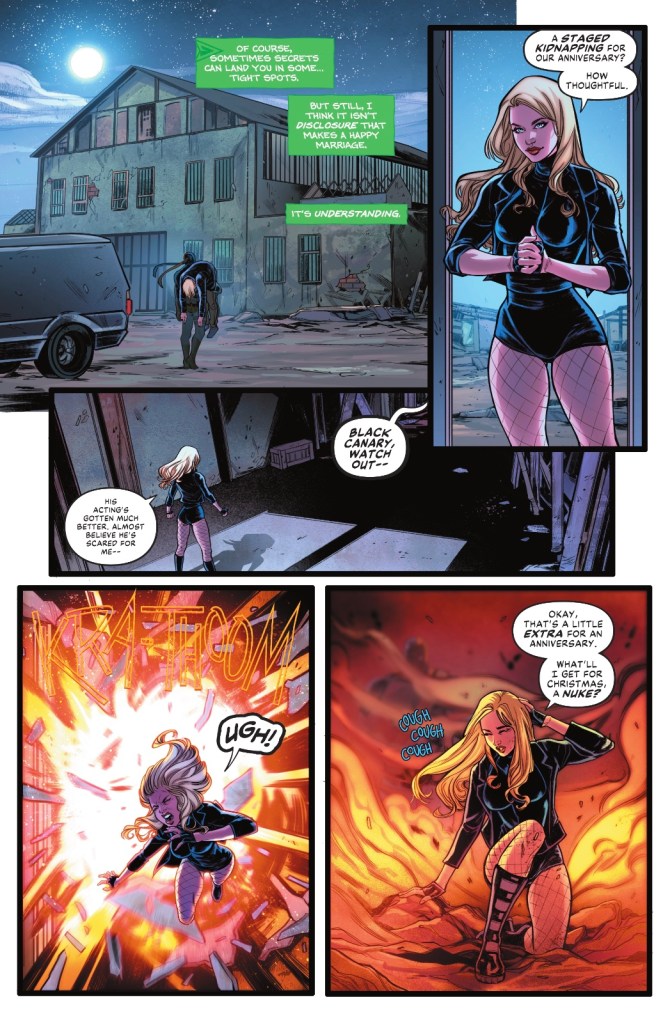
Benjamin Percy and Otto Schmidt, who gave us a fine GA run in the DC Rebirth era, return to the character to showcase Ollie’s more contemplative side. Schmidt’s art is full-colour gorgeousness, Percy’s script builds to a satisfying climax… but I couldn’t get past Ollie stalking a deer. Heroes shouldn’t hunt. Still, I really enjoyed seeing the old supporting cast.

The art by illustrator Andrea Sorrentino and colourist Jordie Bellaire on Jeff Lemire’s Last Green Arrow Story is stupendous, warm and minty and dusky and moody… but I haven’t the foggiest as to what is going on. An old Ollie goes back to the desert island where he learned to be a bowman, and gets an arrow from a younger version of himself, then happily self immolates. Or something. I dunno.
As it turns out, it is the last Green Arrow story… in this special, anyway. It’s not the last story full stop, though, as the comic ends with a tribute to longtime Ollie author Denny O’Neil. Written by his son Larry, and illustrated by Jorge Fornes with colours by Dave Stewart, it’s a beautiful biography of Denny in comics form. It’s a near silent story, with a very creative, and appropriate, use of word balloons, and it had me in tears.
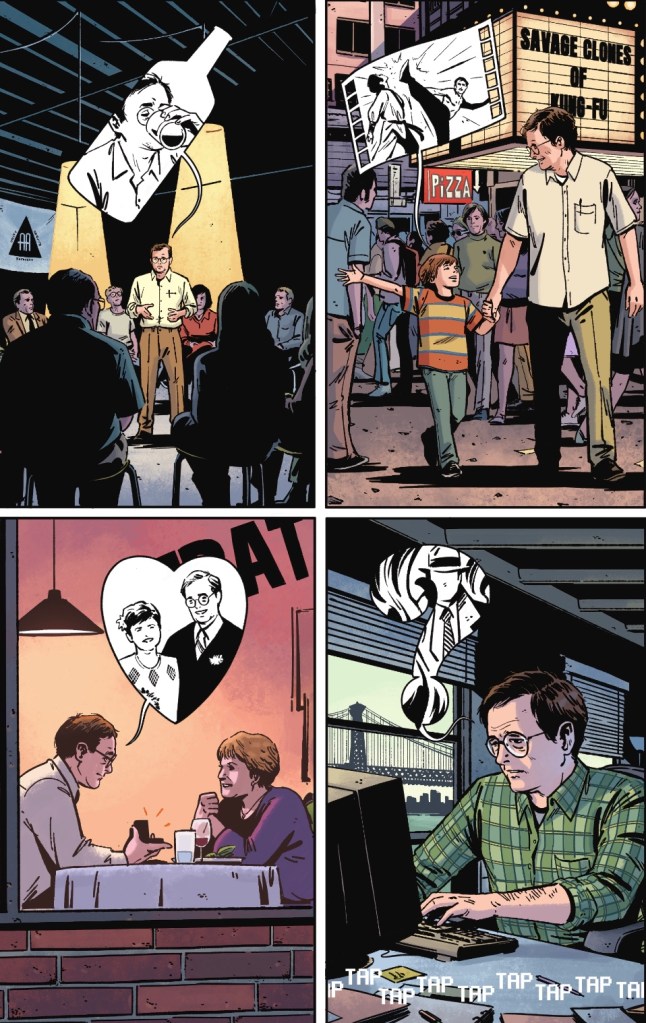
Also guaranteed to get the eyes watering is Oliver Queen’s famous chilli, the hotness of which has been a running gag since at least the Seventies. Here, DC shares the recipe in a fun feature page.

Another feature, this time two pages, looks at Ollie’s capacity for friendship, and it is a hoot.

Once upon a time DC would include all alternate covers with ComiXology releases. No more, which is a shame as the Decades variants for this issue are great. As it is, I have a cover by the excellent Dan Mora; he’s so good that it’s likely my misunderstanding of anatomy that has Ollie’s foreshortened arm looking really off.
While I didn’t love every story – that was always unlikely in a 100-page grab bag – I do love that DC has offered Green Arrow fans a comic stuffed to the brim with nods to his entire history, by creators who care about the Emerald Archer as much as we do. A big tip of the pointed cap to editors Dave Wielgosz, Amedeo Turturro, Ben Meares, Ben Abernathy, publication designer Kenny Lopez and production person Tiffany Huang. As worthy tributes go, this Green Arrow special hits the mark.
There was some fun here even if I do loathe Green arrow post Denny O’Neil. I also hate Black canary being dragged down by him and luckily only one of these stories showcases that. Grell’s story was horrible in that respect. Dinah is marginalized as he always does and frankly, the whole story feels like an allegory for Ollie cheating on Dinah with Shado. Grell is also as ham fisted with characterization as O’Neil.
The Native stuff with Roy felt out of place as well. It was retconned in and has mostly been ignored since, along with that ludicrous Vandal Savage tie (which would be an awesome way to explain Lian’s revival I realize as I type). Using it now after years of ignoring reads like cultural appropriation frankly.
LikeLike
Dinah being marginalised was another reason I never bothered with Grell GA after trying the odd issue. I read this issue’s story as hinting at an affair with Shado, though looking around online it seems she raped him while he was drugged… there seems to have been a lot of that going on at DC. As for Roy, that Navajo origin dates back to at least 1959, and I don’t think it was a retcon, the Native American background was always there. I don’t remember the Vandal Savage business, was that in the Arsenal mini-series? The Rick Mays art drove me away.
LikeLike
Jeff Lemire’s “Last Green Arrow Story” shows a curmudgeonly, old Ollie receiving his heavenly reward from his youthful doppelgänger on The Island where he was first transformed into a great hero. The Arrow Totem grants True Enlightenment and perhaps Immortality. Ollie’s spirt now serves as the Magus of The Island, while his physical form transfigures into the heavenly realms. In effect, Ollie receives his dirty wings, hallelujah 😀
LikeLiked by 1 person
I see it now! Ollie is part of the Green, he’s the Arrow Elemental, and joining the Parliament of Bowmen! Obvious really…
LikeLike
I’m halfway through the book, picked yesterday up on the strength of this review, and what strikes me so far is how often these very short stories (and some in Wonder Woman: Black and Gold) force the writers to go for “fun” and “entertainment.” It occurs to me that the modern sprawl of six-issue arcs, which I don’t oppose generally, wallow in spectacular violence or ridiculous plot twists. Or maybe it’s just the need for “significance,” because so far Gene Yang’s arc on Batman/Superman is quite fun, along with all the action and zig-zagging. But I digress …
I’m just thinking that “What am I supposed to do with eight pages?” seems to lead to “Tell a fun, perhaps charming story,” and one can only wish that were the point more often …
LikeLiked by 1 person
That’s a great observation. A few years ago it seemed that the art of the short story was dead, with few writers able to produce a satisfying 8pp done-in-one, but now we’re regularly getting good stuff in these giants. Long may it continue!
LikeLike
I enjoyed some stories, felt kind of lost with many others, not knowing enough of the history. I think by the time of the famous GA/GL series, I was not paying attention to DC Comics. It didn’t even make sense that they two would be paired.
No one who reviewed this book saw anything in Tamaki’s story but Silver Age homage, kind of goofy. But I see double entendre, innuendo in words or images on almost every page, playing into the idea that the relationships with sidekicks in those days were not so innocent, though I took it as playful and winking, not as serious commentary. But am I reading too much into it?
The Lessons in Friendship pages aren’t credited – but given how similar the page motifs are, I’ll guess it’s the same team of McCullar and Gleason who did the Chile Recipe. These mini-stories aren’t mentioned in the Table of Contents either.
I don’t grasp the Lemire story either, and wonder if Brad above was serious. Sorrentino’s work is beautiful, though.
The O’Neil tribute was really sweet and well done, and left me choked up at the end.
So now I learned that TV Arrow’s Thea “Mia” “Speedy” Dearden Queen was loosely based on the original Mia Dearden, and then Thea was imported back into the comics as Emiko Queen. How surprising!
LikeLiked by 1 person
Well, I’ve been through that first story again, with my filthiest head on, and I still see nothing but a slightly camp, hugely fun homage. Would you give examples?
LikeLike
Maybe some of this is far-fetched. But Tamaki has infinite choices, and these are among the words and images she chose to include:
manhole
drag
bottom dollar
the quiver (can be a pun)
the arrow that Speedy closely examines
the gooey messes the paint arrows leave
And finally, she gives us a sweating Speedy in workout clothes
I don’t know, maybe I’m just being juvenile. If it’s real, these jokes are not really in good taste, and it bothers me that they flew under the radar, like private jokes. Were her editors in on it? It wouldn’t be right to try to sneak stuff past them, though they are incredibly busy and I’m sure it happens all the time. But maybe I’m the only one with the dirty mind!
I wonder when I first perked up about it. (See, if Tamaki wrote that sentence in the story, I’d cite that one too.) Maybe it was Speedy and the gym clothes, or maybe it was Speedy looking at the arrow, but at a certain point I said ok, I am seeing a pattern here.
But you know, the American version of The Office proved you could insert jokes almost anywhere. (“That’s what she said!”)
LikeLike
Thanks. As a Brit who grew up in the Seventies, I was basically raised by Benny Hill and the Carry On… films, I reread the story with my ‘oo-er missus’ head on, and I still don’t see it. Quivers, arrows, training, it’s all pretty basic to early Green Arrow. Heck, you can’t have a GA story without the first two. Of course you can look for the old ‘homosexual wish dream’ of the Wertham hysteria, but all I see is an affectionate, perhaps amused attempt to get that Golden/Silver age vibe.
If anyone else has any opinions, shoot them this way!
LikeLike
PS I’ve never seen the US Office, I don’t like those faux documentaries. Couldn’t get through a single episode of the original.
LikeLike
I liked the US Office, which I saw first, but never liked the UK version which I didn’t watch much of. But I do find Ricky Gervais very funny as a stand-up comedian, and liked him in other roles he’s played.
LikeLiked by 1 person
I find him unbearably smug under any circumstances!
LikeLike
I never enjoyed him either and I also dislike his US counterpart in the office, Steve Something. I don’t like stand up or MCing by comedians like Grevais either. The characters he likes to play are okay as an ensemble but as the star? Yuk. My sister once made me watch an episode of Extras and he was the sole thing I disliked!
LikeLiked by 1 person
Hi Martin – as you suggested, I’m shifting gears from lurking to commenting. Like you, I couldn’t see the evidence for T.N.’s suggestion about sub-text etc in the first tale. But if there’s one thing the past few years have taught me, it’s that I’m MORE than capable of missing readings that others who are more tuned in to this matter or that can identify far more effectively than I can. So, no, I can’t see it, but that doesn’t mean it’s not there, and I look forward to seeing more, if more there is to come, on this particular matter.
LikeLiked by 1 person
Thanks Colin, I needed a third opinion! I doubt we’ll settle the matter, but if nothing else, I have you here for posterity!
LikeLike
Good one, Martin.
I think I’m being teased by Colin, but there were two I forgot to include in my list:
Dead end
Exposed
I’ll let you know if I “come” up with more!
LikeLike
If Colin is teasing you, check the front door, Mogo wants to party…
As for those two, that’s really reaching! I still don’t get ‘quiver’ as pun… Mr Queen makes Roy quiver? Heck, ‘Queen’, there’s a name.
LikeLike